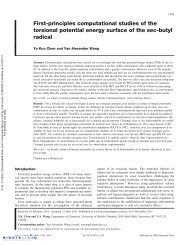Electrospray ionization source geometry for mass spectrometry: past ...
Electrospray ionization source geometry for mass spectrometry: past ...
Electrospray ionization source geometry for mass spectrometry: past ...
Create successful ePaper yourself
Turn your PDF publications into a flip-book with our unique Google optimized e-Paper software.
Trends Trends in Analytical Chemistry, Vol. 25, No. 3, 2006<br />
slurry containing column packing material through a<br />
tapered sprayer [71,72]. Sometimes, a small frit is included<br />
inside the tip of the sprayer to help confine the<br />
packing material. The elimination of post column dead<br />
volume helps to ensure optimal chromatographic per<strong>for</strong>mance.<br />
In addition, it has been suggested that the<br />
presence of packing material in the tapered sprayer acts<br />
similar to a filter, extending tip lifetimes by preventing<br />
plugging. The drawback with this configuration is that<br />
tip replacement due to blockage or damage requires the<br />
entire column to be replaced. Electrical contact can be<br />
established at the sprayer tip or distal to the tip end.<br />
Amirkhani and co-workers recently compared the<br />
efficiency of four different sheathless electrospray emitter<br />
configurations <strong>for</strong> a nanoflow LC system [73]. Two of the<br />
configurations used on-column emitters with the applied<br />
voltage either at the outlet or the inlet end of the<br />
column, and the other two had emitters coupled to<br />
columns, with the electrical connection at either the<br />
sprayer tip or the low dead volume union. It was<br />
demonstrated that all the configurations worked equally<br />
well, provided the connections were made with minimal<br />
dead volume [73].<br />
Currently, most major MS manufacturers (e.g., Thermo<br />
Electron, MDS SCIEX, Agilent Technologies, and Waters/<br />
Micro<strong>mass</strong>) make the nanoelectrospray <strong>source</strong> available.<br />
The number of applications using electrospray at low flow<br />
rates is very large, and outside the scope of this paper.<br />
Wood et al.’s 2003 review article is a good starting point<br />
and a <strong>source</strong> of references [47].<br />
5.1.2. High flow rate. If the flow rate is in the range<br />
0.05–3 mL/min, sensitivity can be an issue, due to the<br />
decrease in <strong>ionization</strong> efficiency resulting from large<br />
droplet size. ESI-MS is widely interfaced with LC, so high<br />
flow rates are often necessary. One solution to this<br />
problem is to employ a splitter that allows only a limited<br />
volumetric flow rate to reach the MS interface. Under<br />
these conditions, part of the eluent is wasted and connection<br />
dead volume is a common problem. A more<br />
practical approach adopted by manufacturers is to<br />
sample the spray from a region, peripheral to the main<br />
droplet trajectory, where the mist is much finer. This is<br />
done by simply re-orienting the sprayer relative to the<br />
interface so that the fine droplets from the exterior of<br />
the spray plume can enter the sampling inlet, while the<br />
majority of large droplets are directed away from the<br />
entrance [74]. To minimize contamination, many major<br />
MS manufacturers now sample orthogonally from the<br />
spray plume <strong>for</strong> many applications (e.g., Agilent Technologies,<br />
Waters/Micro<strong>mass</strong>, and MDS SCIEX). An<br />
example of this is shown in Fig. 7 <strong>for</strong> an Agilent Technologies<br />
<strong>source</strong> incorporating an additional asymmetrical<br />
lens.<br />
The asymmetrical lens is essentially a half-full, partial<br />
cylinder electrode operated at high voltage during the<br />
250 http://www.elsevier.com/locate/trac<br />
asymmetrical<br />
lens<br />
orthogonal<br />
nebulizer<br />
nebulized<br />
analyte solution<br />
HPLC eluent<br />
atmospheric pressure<br />
1.5 torr<br />
ion transfer capillary<br />
to MS<br />
Figure 7. Schematic of an ESI <strong>source</strong> configuration developed by<br />
Agilent Technologies.<br />
electrospray process [75]. The purpose of the electrode is<br />
to help initiate and sustain electrospray. Conversely,<br />
other groups have attempted to use various types of<br />
auxiliary electrodes [76–78] to focus ions at atmospheric<br />
pressure.<br />
Also exploiting the advantages of orthogonal sampling<br />
is the Waters/Micro<strong>mass</strong> Zspraye [79,80] interface,<br />
shown schematically in Fig. 8. The spray is first sampled<br />
orthogonally through the sampling cone into a low<br />
pressure chamber. An extraction cone (skimmer) is oriented<br />
at a right angle relative to the axis of the spray to<br />
sample <strong>for</strong> a second time into the next differentially<br />
pumped vacuum stage. The double orthogonal sampling<br />
system prevents solvent and neutral molecules from<br />
entering the analyzer, resulting in reduced chemical<br />
background [81]. Larger cone apertures are used to<br />
Figure 8. Schematic of the Zspray TM <strong>source</strong> configuration used by<br />
Waters/Micro<strong>mass</strong>.



